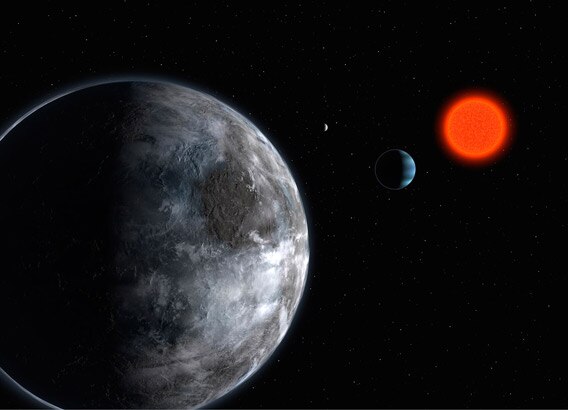Create a free profile to get unlimited access to exclusive videos, sweepstakes, and more!
Eight Newly Found Exoplanets Look to Be “Just Right”

Astronomers are discovering exoplanets—worlds orbiting other stars—all the time, but eight new ones recently found are more exciting: They are roughly the size of Earth, and all orbit in their stars’ habitable zones (the distance where conditions are good for liquid water on a planet’s surface). Two in particular are pretty close to having potentially Earth-like conditions, which is very interesting indeed.
The planets were all first found using NASA’s Kepler space telescope. Kepler has been looking for several years at one patch of the sky containing about 150,000 stars. If planets orbit any of those stars, and the orbits happen to be seen edge-on from Earth, the planets will pass directly in front of their stars, dimming them ever so slightly. This “transit method” has been amazingly successful, and Kepler recently had its 1,000th exoplanet confirmed.
The sizes of the planets can be found by determining how much the starlight dims; the bigger the planet, the more star it blocks. Quite a few planets have been found roughly the size of the Earth, but only a handful have been at the right place from their star to have potentially clement temperatures.
Each of the eight planets in this new clutch of exoplanets is less than twice the diameter of Earth; planets much bigger than that are thought to have too much gravity as they form, attracting and keeping a thick atmosphere, becoming gas giants like Jupiter or Neptune. And all of the eight are at the right distance from their stars to be in the “potentially Earth-like” category.
I’ll note we don’t know anything about these planets other than their distances from their stars, the lengths of their orbital periods, and their size. Most importantly, we don’t know their masses. A planet could be the same size as Earth, but much more or less dense, causing surface conditions that could be quite different than our home world’s.
Still, two of the planets look pretty interesting. Called Kepler-438b and Kepler-442b, they both orbit red dwarf stars, ones that are smaller and cooler than the Sun. The planets are closer in, though, so they still receive enough light and heat to be potentially nice places. 438b has an orbit just 35 days long, and is only 1.12 times bigger than Earth. It’s close enough to its star that it gets about 1.4 times as much light as Earth does from the Sun.
442b is about 1.3 times bigger than Earth, and has a year 112 days long, receiving about 0.7 times the light Earth does from the Sun. Given their sizes, there’s a good chance one or both exoplanets are rocky, like Earth. (NOTE: These sizes are in slight disagreement with what I found at the NASA exoplanets database for 438b and 442b; if I find out more, I’ll update.)
Before you get too excited, you should know they are 470 and 1,100 light-years away, so we won’t be visiting them any time soon. In fact, the distance is so great that other telescopes can’t even detect these planets. Their existence was validated using a sophisticated piece of software called BLENDER, which models the observations of exoplanets and runs through millions of possible configurations to see how likely the planets are to be real, as opposed to something that might look real (for example, a variable star in the same field of view that gets brighter and dimmer, mimicking a planetary transit). They find the likelihood of reality for these eight planets to be quite high, and followed up the Kepler observations with quite a few other techniques to better understand them.
I also want to stress that the notion of a “habitable zone” is fuzzy. Technically, Venus is in the Sun’s habitable zone (and also has about the same size and mass as Earth), but it’s a hellish pit. Atmosphere plays a huge role in habitability. Without our air, the Earth’s average temperature would be well below the freezing point of water. Mars is also technically in the Sun’s habitable zone but has a thin atmosphere and is terribly cold (I sometimes wish we could switch Venus and Mars; given time would they both be more easily terraformed?). Outer moons in the solar system are known to have liquid water, yet they are well outside the strict habitable zone of the Sun. It’s an interesting concept, and a good guideline, but don’t let it restrict your thinking too literally.
So what does all this mean? Well, a few years ago we didn’t know if our solar system was unique, or if other planets existed. Now we know of thousands. And as we get better at finding them, we discover ones that are smaller and likely to be more Earth-like. Eventually we’ll build better telescopes that are capable of observing them and characterizing them even further, providing a true census of Earth-like worlds in our galaxy.
Extrapolating from what we know, there are billions—yes, billions—of Earth-sized planets in our galaxy alone. How many of these are habitable? How likely is life Out There? We still don’t know … but we’re well on our way to finding out.


























